7 The Tree of Life
The Tree of Life activity was developed by narrative therapists in South Africa and was initially used with HIV patients and their families. It helps people explore their cultural history, gifts, allies, and the personal elements that help them be resilient when faced with difficult experiences. This activity was introduced to me by Jonny Morris and it became an integral part of learning events for staff and students at the University of Central Asia.
Source: Narrative Therapy Tree of Life Dulwich Centre
Purpose:
Participants will have an opportunity to reflect on their personal background, strengths, support systems and aspirations. They will also reflect on how trees together create a forest which is more resilient to the storms of life.
Learning Objectives
Participants will:
- Reflect on the cultural factors, people, personal strengths and future dreams that create each unique identity.
- Recognize the elements that support themselves and peers during challenging times.
- Create a visual representation of their personal identity, support systems and resilience strategies that can provide reminders to them during difficult times.
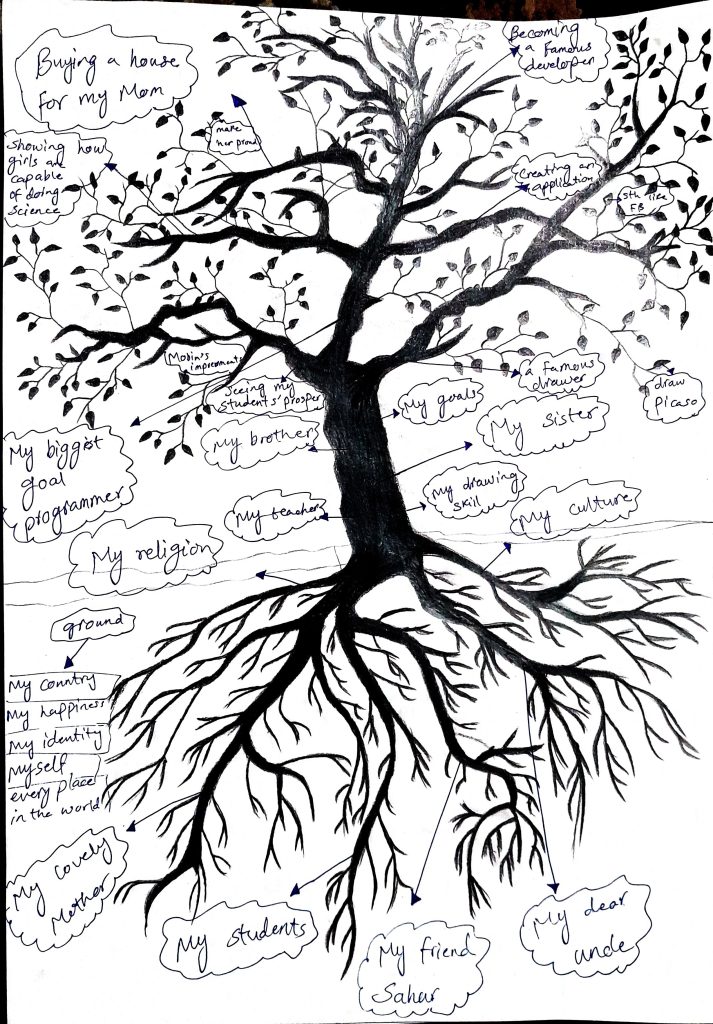
Activity Directions
1. Introduce process: Tell participants that they will have 40 minutes to design a tree that represents their life. This self-reflection process will help them to understand their own resiliency and to get to know their peers better. The following information can be given to people in a handout, embedded in a power point or written on the whiteboard:
This project is about identifying all the different aspects of your identity, including your family, culture, spiritual beliefs, future goals, personal strengths and support system.
For each section, draw part of your tree and write notes around it.
Roots: Where do you come from? What grounds and anchors you? (places, culture, ethnicity, spirituality, values, mentors)
- What roots do you have in your life? How important are these?
- Where were you born? Where did you go to school?
- What is your culture, country, beliefs, community that have shaped you?
- Do you have any favourite memories that are foundational for you?
- What are the essential roots that stabilize you?
Ground: Every day life right now
- What is the ground like in your life? Is it fairly stable or frequently changing? (could represent with flat or bumpy ground) What supports you in your day to day life?
- What daily habits keep you healthy and grounded?
- Do you have a favourite place that you visit?
Trunk:
- What are the skills, abilities, strengths and personal gifts you offer the world?
- What are your personal qualities that help you cope with challenges?
- What are you good at? What makes you unique?
- What are some ways other people describe your personality and strengths?
Branches
- What are your hopes and dreams for the future?
- What do you want to contribute to your family, community or country?
- What will help you achieve these dreams?
- What are your goals for education, career, personal growth or community service?
Leaves:
- Who inspires and supports you?
- What teachers, friends, family members, artists, thinkers have shaped you?
- What fictional characters or heroes or heroines have influenced you?
- Who are your mentors and people you admire?
- Are there any “leaves” who have died or fallen from the tree but still are important to you?
Optional: flowers and/or fruit
- What gifts of love or time or energy have you been given that you value?
- What has flowered in your life that you are proud of?
- What are your accomplishments?
Optional: Compost or fallen branches
- Are there branches of your tree or parts of your life that used to be there but have now ended?
- What things do you want to let go of and allow them to compost into soil for your tree?
2. Draw and Create: Have a table set up with a variety of art materials. Use whatever is available. Beautiful trees have been created with just pencil and paper, but if you have more time and art materials available, a variety of choices sometimes helps people who are less confident at drawing. I often have markers, glitter, stickers, glue, collage materials, and big pieces of poster paper available.
3. Timing Announcement: Let group know when they have 15 minutes left to complete their tree. As people finish, tape their trees to the wall or whiteboard to create your “group forest.”
4. Gallery Walk and Discussion: Encourage participants to take time to do a “gallery walk” and look at the individual trees. After a few minutes, ask them the following questions:
Debriefing Questions:
- What are some of the ways these trees will survive if there are big storms?
- What are your thoughts on whether trees survive storms better alone or in a forest? Why?
- How is this relevant to your life?
- How might the roots and branches of these trees grow together over time? How might that help the forest stay strong? How does this metaphor apply to your lives?
- What other reflections do you have about creating your own tree or seeing this forest of trees?
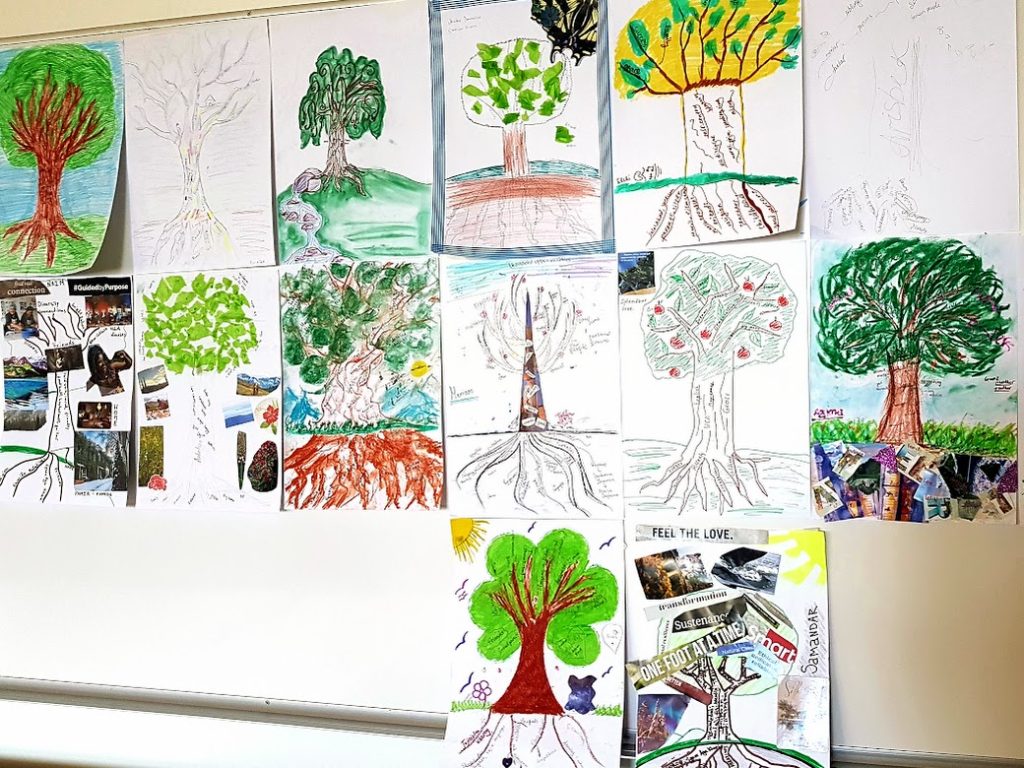
Forest of Resilience, Kyrgyzstan, First Year University Students

Follow-up Possibilities:
If this is a longer course or a group that will be meeting for a long time, the facilitator could keep the trees and hand them back at the end of the program. Participants can then add to the trees any skills, allies, roots or dreams that are newly developed and reflect on how they have grown since they first created their trees.
Individual Counselling Adaptation:
The Tree of Life is also a powerful activity as part of a personal counselling process. It could be done within a session or as homework between appointments. One option is to complete the tree over several sessions working on one component at a time (i.e. drawing the roots in one session, the trunk next etc.). Creating the tree of life early in the counselling process provides a visual and verbal assessment of a person’s culture, strengths and support network. It is also possible to re-visit the tree and add and change the tree as new insights and awareness emerge. Returning the tree to the counselling client can also be part of the termination reflection process.
On-Line Adaptation:
Introduce the Tree of Life project and ask participants to create their personal tree before the next session. The trees can be made with art materials found at home or created digitally. Ask participants to upload the trees to a learning platform or send as photo attachments to the facilitator. Facilitator can print the trees and tape them to a wall. The online class can discuss their trees in break-out rooms with four participants to a room. When the group reconvenes, the full class can discuss the “forest of resilience” when looking at the trees on the facilitator’s wall or pictures of the forest that are shared in a shared power point. Again, it can be helpful for the facilitator to meet individually with each participant so they can explain their tree and its meaning. The individual sessions deepen awareness of the life journeys of the participants in the group and also provide an opportunity to explore the personal strengths that support each person in their journey. An outcome of the discussion of the branches (hopes and dreams) can be used for action planning on how the person wants to work towards one or several of these long-term goals.
Case Study: KAAJ Project with female Afghan students
“Kaaj Education was established in early 2022, following a series of targeted bomb attacks, including the deadly assault on the Kaaj STEM Tutoring Center in Kabul in September 2022, where hundreds of girls were preparing for the national university entrance exam. The attack was a tragic reminder of the urgent need to support the education of girls in the midst of challenging circumstances. Since then, our journey has been one of resilience, determination, and hope. Despite the adversity, we have made it our mission to light the path of education for girls in Afghanistan, so they may become beacons of transformation, breaking barriers and realizing their dreams.” KAAJ Story
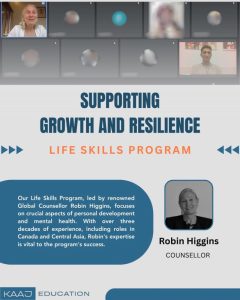 As part of the KAAJ education project, I was asked to facilitate an 8-week program in Resilience Skills. The Tree of Life exercise provides a way for participants to look at their roots, strengths and aspirations. I met with each of the KAAJ students in my course and we talked about their tree and what has kept them going through this difficult time where their schools have been bombed and they are unable to continue traditional education. In the Afghan language KAAJ means pine tree, so this symbol of resilience has many different levels of meaning for these courageous and insightful young women.
As part of the KAAJ education project, I was asked to facilitate an 8-week program in Resilience Skills. The Tree of Life exercise provides a way for participants to look at their roots, strengths and aspirations. I met with each of the KAAJ students in my course and we talked about their tree and what has kept them going through this difficult time where their schools have been bombed and they are unable to continue traditional education. In the Afghan language KAAJ means pine tree, so this symbol of resilience has many different levels of meaning for these courageous and insightful young women.
Read more about KAAJ project education and the innovative Afghan immigrant university students who started this project to support their sisters and the young women of Afganistan who are hoping to further their education abroad. KAAJ Education Project
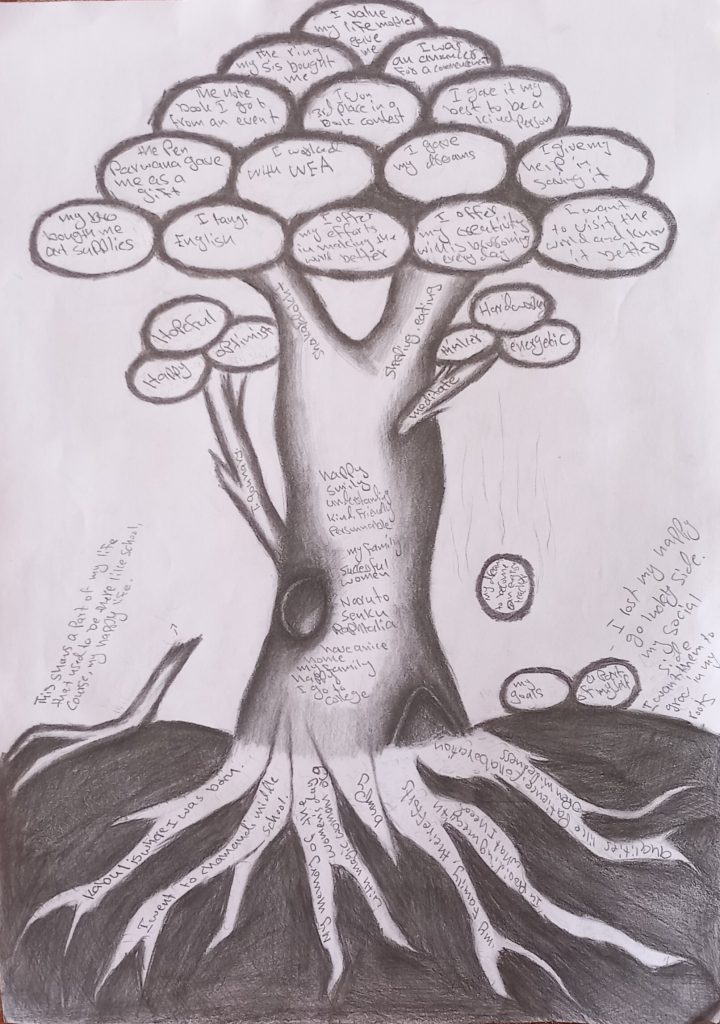
Facilitation Note: This tree and description was created by an Afghan student who is completing her highschool education online and hoping to go abroad for university. When I had an online conversation with her we used her drawing as a starting point to explore how she had coped with the end of her schooling, fear of the Taliban and the ways her family, culture, creativity and persistence have helped her to continue pursuing her goals. The broken branch and parts that have fallen from the tree, are aspects of her life that were changed by the current political situation. However, even with all the set-backs, she was also eager to talk about the beauty of Afghan culture and values and her future goals and aspirations.
Here is this student’s description of herself and her experience of the Resilience Skills class:
“I am a 16 year old who is full of ideas and thoughts about the future. I am a student and artist, and my hobbies are reading comics, drawing, studying, and meditating. During the class the one thing I liked best was how I felt like my words mattered.”
Note: This pencil sketched art piece is also an example of how this activity can be done with minimal art materials.
Here is another description about how creating the Tree of Life, helped an Afghan student to make sense of her life. I love the idea that reflecting and expressing ourselves through words and art can change a sense of “blurriness” to one of clarity:
“Drawing the tree of my life was a great experience for me because before this I had never done such a thing. While I was drawing my tree, I was exploring more about myself. It was like these parts of me were blurry things in my mind, but when I drew the tree and wrote everything on that paper, they lost their blurry shapes and came to be real because I kept thinking more and more about these different aspects of who I am. I looked at all the trees that my friends drew for this project and they were really great. By seeing their trees, I know more about them and their lives.”
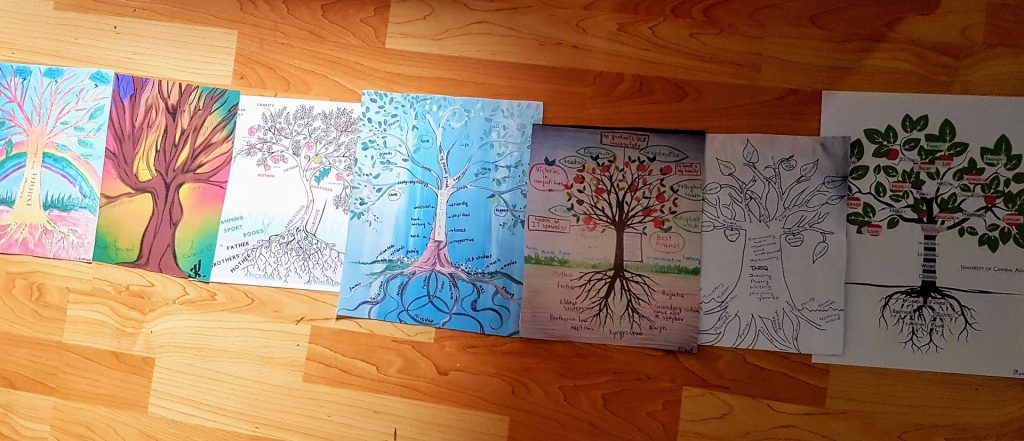
Materials and Resources Needed:
- Poster Paper
- Art Materials (markers, pencils, collage materials, glitter glue, scissors, coloured paper, pastels, pencil crayons, stickers etc.)
- Tape to create forest on the wall
Source
https://dulwichcentre.com.au/the-tree-of-life/
Alternative Activity with the Coconut Tree used for Cultural Exploration
The coconut palm tree: a metaphor for Island family life. This article utilises the coconut palm tree as a metaphor for Torres Strait Island family life, where the roots represent Heritage, the trunk represents Tradition, and the growth of leaves & maturing of coconuts/fruit, represent Culture.
Uncle Steve Mam developed this metaphor and it is used in Australia for exploring visible and hidden aspects of culture.
